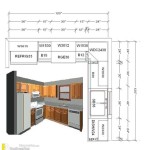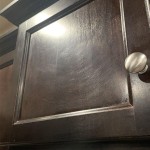How To Organize Your Kitchen Pots
The organization of kitchen pots and pans is a common challenge for many households. Efficient pot storage not only frees up valuable cabinet space but also simplifies the cooking process by ensuring that the right pot is readily accessible when needed. A well-organized pot storage system minimizes clutter, prevents damage to cookware, and contributes to a more functional and enjoyable kitchen environment. This article will explore several effective methods for organizing kitchen pots, providing practical advice for optimizing storage based on available space, budget, and personal preferences.
Before commencing any organizational effort, it is critical to assess the current situation. This involves taking inventory of all pots, pans, and lids, evaluating available storage space, and identifying any pre-existing organizational systems. This initial assessment forms the basis for developing a targeted and effective storage strategy.
Begin by removing all pots and pans from their current storage locations. This provides a clear overview of the entire collection and allows for a thorough cleaning of the storage space. Next, categorize the pots and pans by type (e.g., saucepans, frying pans, stockpots) and size. This categorization will assist in determining the most logical arrangement for storage.
It is also prudent to evaluate the condition of each pot and pan. Items that are heavily damaged, irreparably stained, or rarely used should be considered for donation or disposal. Reducing the overall quantity of cookware to be stored significantly simplifies the organizational process and maximizes available space.
Available storage space is the primary constraint in any pot organization project. Consider the dimensions and configuration of cabinets, drawers, and pantry space. Also, evaluate the potential for utilizing wall space or overhead areas for pot storage. A careful assessment of available space will dictate the most appropriate storage solutions.
Existing organizational systems, such as cabinet organizers or drawer dividers, should be evaluated for their effectiveness. Determine whether these systems can be adapted to accommodate the pot collection or whether alternative solutions are required. The goal is to integrate the new pot organization system seamlessly with existing storage infrastructure.
Optimizing Cabinet Space for Pot Storage
Cabinets are a traditional and often readily available storage location for pots and pans. However, without proper organization, cabinets can quickly become cluttered and inefficient. Several strategies can be employed to maximize cabinet space for pot storage. These include utilizing vertical space, implementing pot organizers, and employing door-mounted racks.
Vertical space within cabinets is often underutilized. Implementing tiered shelves or stackable organizers allows for the efficient layering of pots and pans based on size. Larger pots can be stored on the bottom shelf, while smaller pots and pans can be placed on upper shelves. This arrangement maximizes the available vertical space and prevents pots from being haphazardly stacked, which can lead to damage and difficulty in retrieval.
Pot organizers are specifically designed to create designated slots for each pot and pan. These organizers come in various forms, including adjustable dividers, wire racks, and pull-out systems. They prevent pots from shifting or nesting together, making it easier to access individual items without disturbing the entire stack. Pot organizers are particularly useful for storing frying pans and saucepans, which tend to be more prone to scratching and damage when stacked.
Door-mounted racks offer an alternative storage solution that utilizes the often-overlooked space on the inside of cabinet doors. These racks are ideal for storing lids or smaller, frequently used pots. Ensure that the racks are securely mounted and that the weight of the stored items does not overload the cabinet door hinges. Regularly inspect the door-mounted racks to ensure their stability and prevent potential accidents.
Leveraging Drawers for Efficient Pot Storage
Drawers, particularly deep drawers, can be an excellent option for pot storage, provided they are properly organized. The key to effective drawer storage is to prevent pots from rolling around and to maximize the use of available space. Drawer dividers, custom inserts, and strategically placed non-slip mats can significantly improve pot organization within drawers.
Drawer dividers create designated compartments within the drawer, preventing pots from shifting or colliding with each other. These dividers can be adjustable, allowing for customization based on the size and shape of the pots being stored. Drawer dividers are particularly useful for organizing frying pans and saucepans, keeping them separated and easily accessible.
Custom inserts, such as wooden or plastic trays molded to the shape of specific pots and pans, offer a more tailored and sophisticated storage solution. These inserts can be designed to accommodate the exact dimensions of the pot collection, maximizing the use of drawer space and providing a secure and organized storage environment. While custom inserts may require a greater initial investment, they offer a superior level of organization and protection for cookware.
Non-slip mats provide a simple and cost-effective solution for preventing pots from sliding around within drawers. These mats are placed on the bottom of the drawer to provide a textured surface that grips the pots and pans. Non-slip mats are particularly useful for storing heavier pots and pans that are more prone to movement. Regularly clean the non-slip mats to maintain their effectiveness and prevent the build-up of food debris.
Exploring Alternative Pot Storage Solutions
In situations where cabinet and drawer space is limited, alternative pot storage solutions may be necessary. These solutions include utilizing wall-mounted racks, hanging pot racks, and freestanding storage units. These options offer creative and space-saving ways to store pots and pans outside of traditional storage areas.
Wall-mounted racks provide a visually appealing and accessible storage solution. These racks are typically made of metal or wood and are attached to the wall using screws or anchors. They offer a convenient way to store frequently used pots and pans within easy reach of the stovetop. Ensure that the wall-mounted rack is securely installed and that it can support the weight of the pots and pans being stored. Consider the aesthetics of the rack and its compatibility with the overall kitchen design.
Hanging pot racks are suspended from the ceiling and provide a dramatic and space-saving storage solution. These racks are particularly well-suited for kitchens with high ceilings. Hanging pot racks offer excellent accessibility and allow for the display of cookware. Ensure that the rack is securely attached to ceiling joists and that it can support the combined weight of the pots and pans. Consider the height of the rack and its potential impact on headroom.
Freestanding storage units, such as kitchen islands or rolling carts, can provide additional pot storage space. These units can be strategically placed in areas where extra storage is needed. Kitchen islands often include built-in drawers and cabinets that can be used for pot storage. Rolling carts offer a flexible and mobile storage solution that can be easily moved around the kitchen as needed. Choose freestanding storage units that complement the existing kitchen décor and provide ample storage space.
Regardless of the chosen storage method, maintaining organization is an ongoing process. Regularly evaluate the pot storage system and make adjustments as needed. Implement a routine for decluttering and reorganizing the pot collection. This will ensure that the storage system remains efficient and effective over time.
Implementing a consistent system for replacing pots and pans after use is crucial for maintaining organization. This prevents the accumulation of dirty pots and pans in the sink or on the stovetop. Designate a specific area for washing and drying pots and pans and ensure that they are promptly returned to their designated storage locations after cleaning.
Periodically evaluate the pot collection and identify any items that are no longer needed or used. Consider donating or discarding these items to reduce clutter and maximize storage space. This process should be done at least once a year to ensure that the pot collection remains manageable and efficient.
By implementing these strategies and adhering to a consistent maintenance routine, it is possible to achieve a well-organized and functional pot storage system that enhances the overall efficiency and enjoyment of the kitchen.

Organizing Your Pots And Pans Jamonkey

Organizing Pots And Pans Elite Kitchen Blog

How To Organize Pots Lids Pans 8 Kitchen Organization Ideas Organatic
:max_bytes(150000):strip_icc()/overthedoorpotlidorganizer-bf81a6cfedb04f86bc2c62eb27d8e583.jpg?strip=all)
7 Expert Tips For Organizing Your Pots And Pans

10 Awesome Tips For Organizing Pots And Pans A Cultivated Nest

How To Organize Pots And Pans Smart Ways Cooking Tools

10 Awesome Tips For Organizing Pots And Pans A Cultivated Nest

Organizing Pots And Pans Ideas Solutions

Organizing Pots And Pans In A Corner Cabinet Smallish Home

10 Awesome Tips For Organizing Pots And Pans A Cultivated Nest








